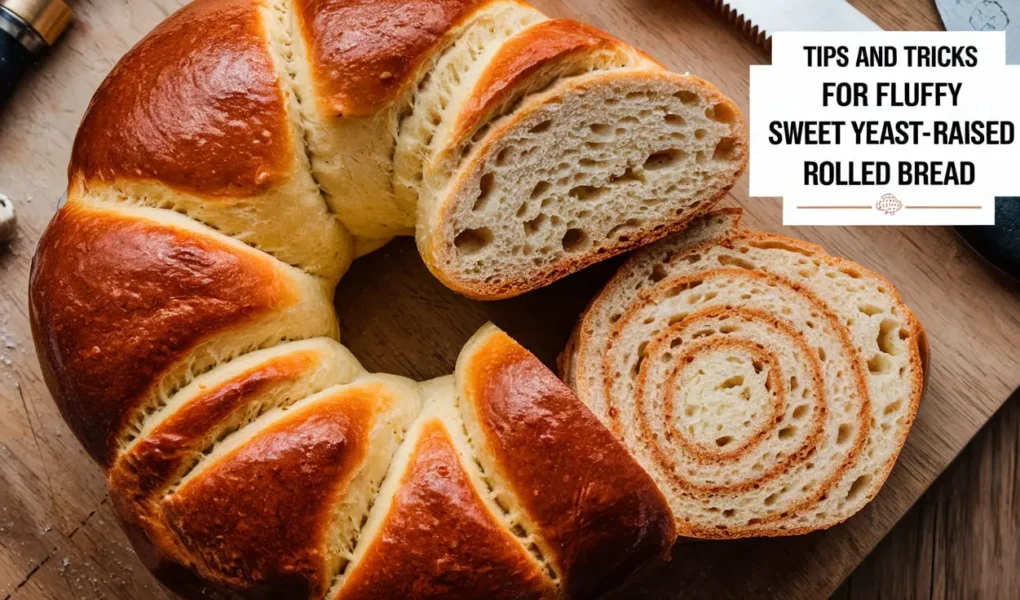Sweet yeast-raised rolled bread is a favorite for many, whether it’s a cinnamon roll or a jam-filled pastry. The soft, fluffy texture paired with a sweet filling makes it an irresistible treat. However, achieving that perfect fluffiness can be tricky. But don’t worry! With the right techniques, anyone can master this delicious bread. Below are essential tips and tricks to help you create the fluffiest sweet yeast-raised rolled bread.
Use Fresh Yeast
Yeast is the most important ingredient in any yeast-raised bread. It’s responsible for making the dough rise and creating that light, airy texture. Always check the expiration date on your yeast package. If the yeast is old or inactive, your dough won’t rise properly, and your bread will be dense instead of fluffy.
Tip: For best results, proof your yeast by mixing it with warm water (about 105°F to 115°F) and a teaspoon of sugar. Let it sit for 5-10 minutes. If it bubbles and foams, your yeast is active and ready to use. If not, it’s time to get fresh yeast.
The Right Temperature for Your Dough
The temperature of your dough and the environment in which it rises plays a significant role in how fluffy your bread turns out. If your dough is too cold, the yeast will not activate properly, and the dough will not rise as much. On the other hand, if the dough is too hot, it can kill the yeast.
Tip: Keep your dough in a warm, draft-free place while it rises. A good spot is the oven (turned off) with just the oven light on. The gentle warmth from the light will help the dough rise beautifully. Cover the dough with a damp towel to keep it moist and prevent a crust from forming on the surface.
Knead the Dough Properly
Kneading is crucial for developing the gluten structure in the dough, which helps trap air and creates the fluffy texture. If you knead the dough too little, it will lack structure and be dense. Over-kneading can make the dough tough.
Tip: Knead the dough until it becomes smooth and elastic, which usually takes about 10 minutes by hand or 5-7 minutes using a stand mixer with a dough hook. The dough should spring back when you poke it.
Let the Dough Rise Twice
Many bakers make the mistake of only letting their dough rise once. For the fluffiest sweet yeast-raised bread, it’s best to let the dough rise twice. The first rise helps the dough develop flavor and texture, while the second rise ensures a light, fluffy consistency.
Tip: After kneading, let the dough rise in a greased bowl for about 1 to 1.5 hours, or until it doubles in size. Then, punch it down, roll it out, add your filling, and let it rise again after shaping into rolls. This second rise (proofing) is usually 30-60 minutes.
Don’t Overfill the Rolls
When making rolled bread, such as cinnamon rolls, it’s tempting to load them with extra filling. However, overfilling can cause the dough to collapse or become soggy, which prevents the bread from getting that nice, fluffy rise.
Tip: Stick to a moderate amount of filling. Spread your filling evenly across the dough, leaving a small border around the edges so the filling doesn’t spill out during rolling.
Choose the Right Flour
The type of flour you use directly affects the texture of your bread. For soft and fluffy rolls, bread flour is the best choice because it has a higher protein content, which helps form more gluten, trapping air bubbles and giving the bread structure.
Tip: If you prefer an even lighter texture, try mixing bread flour with all-purpose flour in a 50/50 ratio. This will create a balance between structure and softness.
Add Fat for Tenderness
Adding fats like butter, milk, or eggs to the dough enhances the softness and richness of sweet yeast-raised rolled bread. Fats coat the flour proteins, preventing them from forming too much gluten and keeping the bread tender.
Tip: Use whole milk and unsalted butter for the richest flavor. You can also add an egg to the dough for extra softness.
Use Sugar to Feed the Yeast
Yeast needs sugar to grow and activate. In sweet yeast-raised bread, sugar plays a dual role by feeding the yeast and sweetening the dough. However, too much sugar can inhibit yeast activity, so balance is key.
Tip: Stick to the recipe’s sugar measurement. If you want extra sweetness, add more sugar to the filling or glaze rather than to the dough itself.
Roll the Dough Evenly
When you roll out the dough, make sure it’s an even thickness all around. Uneven dough can lead to some rolls rising more than others, resulting in inconsistent fluffiness.
Tip: Roll the dough to a uniform thickness, usually about 1/4-inch thick, for even baking and rising.
Proof for Perfect Rise
Proofing, or the second rise, is crucial to the texture of your bread. If the rolls don’t proof enough, they’ll be dense. Over-proofing can lead to collapsed rolls during baking.
Tip: Let the shaped rolls proof until they are just slightly puffed and doubled in size. This usually takes around 30 minutes to an hour, depending on the temperature of your kitchen.
Bake at the Right Temperature
Baking temperature affects how well your rolls rise and how soft they remain. Too high a temperature can cause the rolls to bake too quickly on the outside while staying raw inside. Too low a temperature can make them dry and dense.
Tip: Bake your sweet yeast-raised rolled bread at 350°F (175°C) for 20-25 minutes, or until they are golden brown and sound hollow when tapped on the bottom.
Avoid Overbaking
Overbaking will dry out your rolls, making them tough instead of soft and fluffy.
Tip: Start checking your rolls around the 18-minute mark. The tops should be lightly golden, and the rolls should feel firm but not hard. You can also insert a toothpick into the center of a roll; if it comes out clean, they’re done.
Use a Tangzhong Starter
A tangzhong starter is a method where a portion of the flour and water is cooked into a roux before being added to the dough. This technique traps more moisture in the bread, resulting in an incredibly soft and fluffy texture.
Tip: To make a tangzhong starter, mix 1/4 cup of flour with 1/2 cup of water and cook it over medium heat, stirring constantly, until it thickens into a paste. Let it cool, and then add it to your dough ingredients.
Add a Simple Syrup Glaze
A simple syrup glaze applied right after baking can add moisture and sweetness to the rolls, making them even more soft and delicious.
Tip: Mix equal parts sugar and water, heat until the sugar dissolves, and brush this syrup over the hot rolls as soon as they come out of the oven.
Store Rolls Properly
Once baked, the way you store your rolls will impact how soft they stay over time. Improper storage can lead to dry bread.
Tip: Store sweet yeast-raised rolled bread in an airtight container at room temperature for up to 2 days. For longer storage, wrap them tightly in plastic wrap and freeze for up to 3 months. Reheat in the oven for a few minutes to restore softness.
Conclusion
By following these tips and tricks, you’ll master the art of making fluffy, sweet yeast-raised rolled bread. Fresh yeast, proper kneading, and careful proofing are essential steps. Add fats for tenderness, roll the dough evenly, and bake at the right temperature to achieve light, airy, and delicious bread every time. Whether you’re baking cinnamon rolls or another variation, these techniques will ensure your sweet yeast-raised bread is always soft and fluffy!




